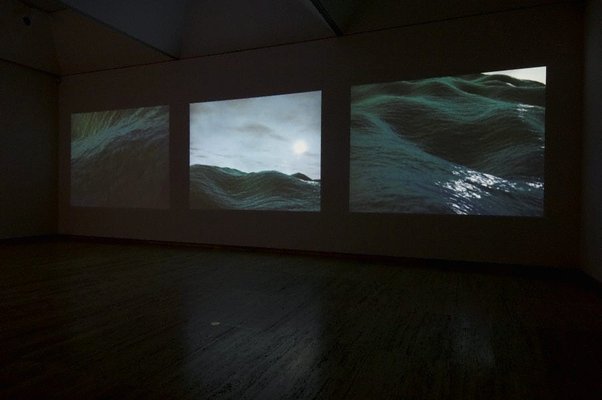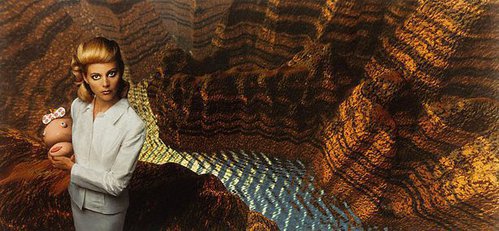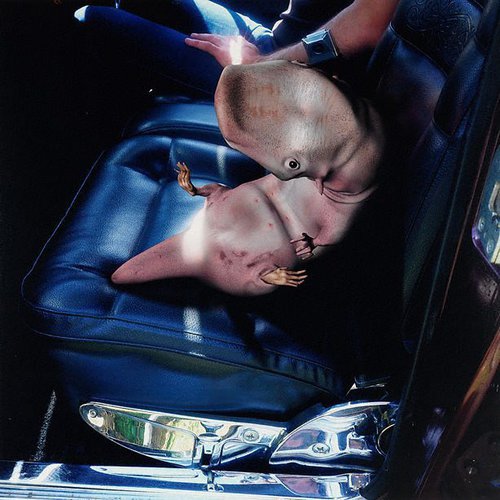






-
Details
- Date
- 2000
- Media categories
- Time-based art , Installation
- Materials used
- three channel digital video, colour, sound
- Edition
- 1/3
- Dimensions
- duration: 00:04:00 min, aspect ratio: 16:9, display dimensions variable
- Credit
- Contemporary Collection Benefactors 2005 with the assistance of Natalia Bradshaw, Andrew Cameron, Mark Flitcroft, Richard Frolich, Leslie & Ginny Green, Amanda Love, Roslyn & Tony Oxley, Stuart Quin, Reg Richardson, Penelope Seidler, Vivienne Sharpe, Ray Shorrocks, Stephen Solomons, Corrinine & John Young
- Location
- Not on display
- Accession number
- 266.2005.a-c
- Copyright
- © Patricia Piccinini. Courtesy Roslyn Oxley9 Gallery, Sydney
- Artist information
-
Patricia Piccinini
Works in the collection
- Share
-
-
About
Patricia Piccinini has divided her body of work, which includes sculpture, digital video installations and digital prints, into three zones: atmosphere, autosphere and biosphere. ‘Swell’ belongs to the first category, atmosphere, and is part of a sequence of works entitled ‘Wilderness’. This sequence considers how our experience of nature and what is considered natural is changing as the world is reshaped by digital and technological developments. In the three-screen projection ‘Swell’, the viewer is enticed by the sound of the ocean but on entering the exhibition space is surrounded by images of a rolling sea that eclipses the horizon. The image becomes nauseating as the ocean surges and heaves, and threatening as we question our ability to survive in these rough seas where we cannot locate ourselves because we have no view beyond the immediate waves.
In ‘Swell’ the immersive visual experience elicits a strong physical and psychological response, making it hard to keep a balanced view of this potentially anxiety causing, frontierless new world. The ocean is convincing and yet has the unsettling hyperreal quality of an entirely digitally created nature. In the past the ‘horizon’ has been a metaphor for the limit of our experience and knowledge, as well as denoting the physical boundary of our visible world. It has also suggested the possibility of transcendence and change, of finding out what is beyond our horizons. This cultural metaphor has lost its force as the world is increasingly defined through information flows and movements rather than geographical, political or even spatial divisions. The sea, which was symbolic of separation and of the time and distance involved in traversing the globe, is here an evocative backdrop to the very different space/time zones of digital media, where rapidity and immediacy are valued and tech-nological developments constantly strive to replace our horizons with a seemingly endless and yet immediate cyberspace. As Piccinini has written of the sea in ‘Swell’ ‘… as a “media space” it most truly represents electronic and communication technology’s increasing consequence in defining the structure and materiality of the contemporary world’.1
The slick sheen of the language of advertising, glossy magazines and marketing feeds Piccinini’s astute manipulation of our responses to her hybrid evolving digital creatures and their environments. In the category biosphere, Piccinini has created her own very plausible artificial lifeforms, the stumbling imperfect offspring of the first attempts by science to breed its own creatures. More recently she has created artificially aged children, which echo the rapid ageing processes of the first cloned creature, Dolly the sheep, and hybrid beasts seemingly part meerkat and part human. Piccinini’s art does not enter into ethical judgments on her subject matter; instead it shows us where our future may lie if everything we desire from science, medicine and technology becomes true.
1. www.patriciapiccinini.net
© Art Gallery of New South Wales Contemporary Collection Handbook, 2006
-
Exhibition history
Shown in 1 exhibition
Patricia Piccinini: Swell, Art Gallery of New South Wales, Sydney, 17 Aug 2005–09 Oct 2005
-
Bibliography
Referenced in 5 publications
-
Centro Cultural Conde Duque, Madrid, Heterosis, Digital Art from Australia, 'Patricia Piccinini, What is installation?', pg.51-64, Madrid, 2002, 51-64.
-
Juliana Engberg, Retrospectology: The World According to Patricia Piccinini, 2002, 20-23.
-
Museum of Contemporary Art, Call of the Wild: Patricia Piccinini, Sydney, 2002, 46-7.
-
Stephanie Radok, Artlink, vol.21, no.1, 'a water or a light', pg.47-54, Adelaide, 2001, 47-54.
-
Wayne Tunnicliffe, Contemporary: Art Gallery of New South Wales Contemporary Collection, 'Reality bytes', pg.382-423, Sydney, 2006, 414, 415 (colour illus.).
-



